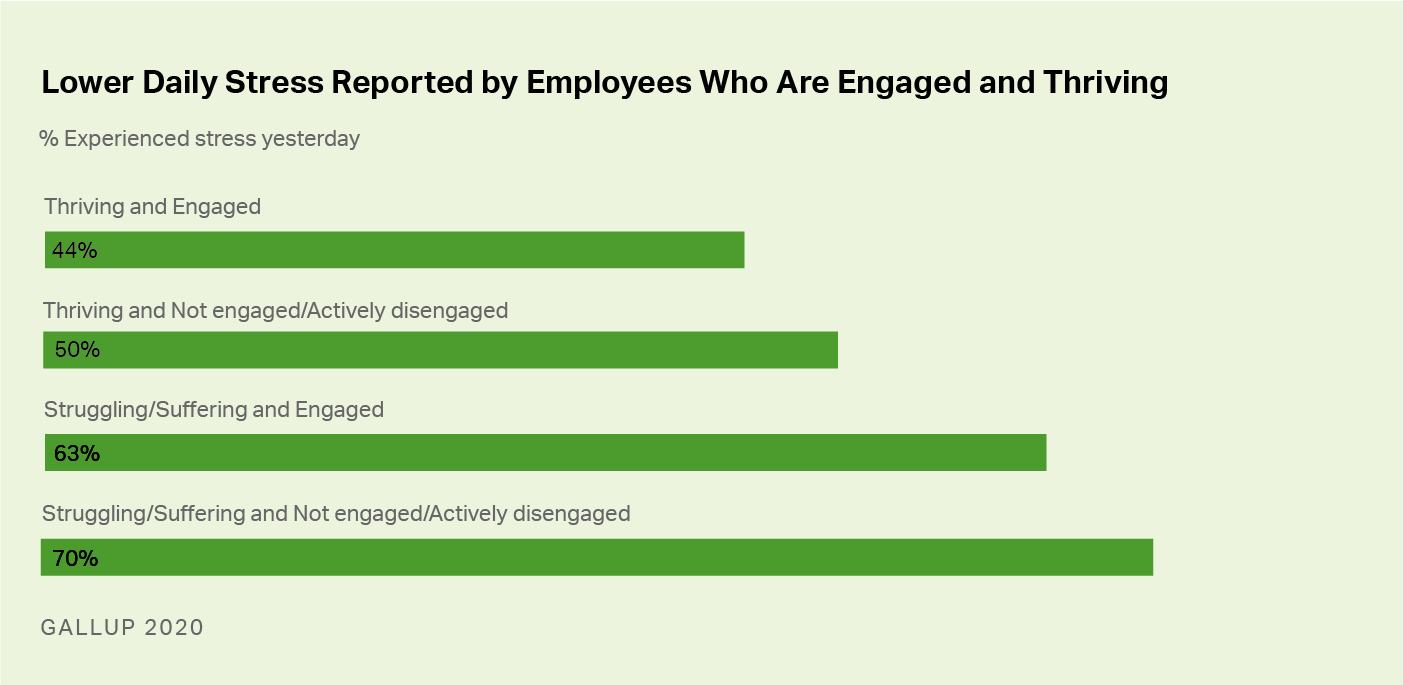Story Highlights
- Gallup's "State of the Global Workplace: 2021 Report" covers workplace trends
- U.S. and Canadian workers reported highest rate of daily stress in 2020
- U.S. and Canada as a region lead the world in employee engagement
2020 was a year filled with unpredictable challenges spanning from furloughs to virtual hiring, from changing market needs to disrupted supply chains, and from changing business models to bringing people back to a new way of working in a post-pandemic world.
None of this has been easy on leaders and managers who must inspire as well as operationalize these changes, all while individualizing to each of their team members.
Gallup's State of the Global Workplace: 2021 Report found that workers in the U.S. and Canada reported the highest rate of daily stress in the world during 2020.
Globally, Gallup's World Poll found substantial increases in daily stress, worry, sadness and anger among workers employed for an employer during 2020. But the U.S. and Canada topped the list on stress. For the first time in a decade, employee engagement also declined globally. But it rose slightly in the Northern America region of the U.S. and Canada. Employees who are engaged at work but are not thriving in their overall lives report a 61% higher rate of burnout often or always. These findings indicate resilience will continue to be top of mind for leaders for the foreseeable future.
Gallup's State of The Global Workplace: 2021 Report provides the only representative sample of the world's workforce. Here are some of the findings from the U.S. and Canada:
1. Working women saw higher daily stress than working men.
Sixty-two percent of female workers in the U.S. and Canada say they experienced stress a lot of the day the previous day, compared with 52% of male workers.
The higher levels of reported daily stress seem to match reports elsewhere that working women, who typically shoulder most of the childcare and other household and elder care burdens, were very stressed during 2020 when many schools were closed or remote.
It is worth noting here that the high stress of working women is nearly universal across the globe.
2. Younger workers saw higher daily stress than older workers.
Sixty-four percent of workers under 40 said they experienced stress a lot of the day the previous day, compared with 51% of those 40 and older. There could be a couple of explanations for this generational divide.
One, older generations may have been able to put the pandemic in perspective, a "this too shall pass" mindset from previous life experiences that made them more psychologically resilient in crisis.
Two, younger workers may have had younger children to care for. Those with preschoolers and early elementary kids who need constant attention may have been torn between parental and work concerns. In contrast, older children are more independent and able to do online education with greater ease. Also, tending to be less established in their careers, younger workers may have perceived a greater threat to their jobs and livelihoods during the pandemic.
3. Daily stress and worry were higher for Canadian workers than U.S. workers.
One might think that stressed-out, overworked employees are a distinctly American experience. However, our data shows that Canadian workers had even higher stress than U.S. workers.
With the complexity of the COVID-19 pandemic affecting different parts of the world at different times, the field periods of Gallup surveys during 2020 should be considered. Data collection in the U.S. occurred throughout 2020. Data for 2020 were collected in Canada in September, which coincided with heavy lockdowns, perhaps influencing high percentages of stress and worry.
4. The U.S. and Canada as a region lead the world in employee engagement.
This could be due to a culture that emphasizes the value of work and the centrality of work to personal identity -- the frequent "What do you do?" question in social introductions. However, that certainly can't be the whole story. Gallup's measure of engagement -- the Q12 employee engagement survey -- does not measure how much Americans value work or how satisfied they are with their chosen profession. Rather, it tracks the workplace experiences and conditions for high employee performance. These conditions include having an opportunity to do what you do best, opportunities to develop and opinions counting at work.
5. Employee engagement in the U.S. and Canada increased in 2020.
That, of course, is not the whole story. As Gallup tracked U.S. engagement throughout 2020, levels went on a wild ride, unlike anything Gallup has seen before. But there may have been two key factors that increased engagement in the U.S.
1. Corporate leaders and managers increased communication with their employees during the onset of COVID-19 and showed more caring and flexibility than in years past.
2. Gallup's research has shown that remote worker engagement can exceed that of in-office workers when managers communicate with them frequently and effectively. Employees in the U.S. reported a higher frequency of meaningful feedback during the second half of 2020. Many workers went fully or mostly remote in 2020, and those managers were perhaps more communicative and supportive than they would've been under normal circumstances.
The lesson here is that leaders really can see substantial gains in engagement and productivity by simply providing greater support and meaningful feedback to their people.
6. However, it's worth keeping in mind that still only about one in three U.S. employees and one in five Canadian employees are engaged at work.
While the engagement trend is up over the past decade, two-thirds of American workers and eight in 10 Canadians are either watching the clock, doing the bare minimum to get a paycheck, or worse, actively working against their employer. There is still much room for improvement. Best practice organizations consistently see engagement over 70% -- with Gallup's engagement measure being a uniquely high bar to reach.
7. Burnout prevention requires both high engagement and high employee wellbeing.
Typically, high engagement makes employees more productive while decreasing their work stress and potential for burnout.

Bar graph showing how employees who are engaged and thriving report lower daily stress than those who are not. 44% of employees who are engaged and thriving in their wellbeing report daily stress compared with 50% of those who are thriving, but not engaged. 63% of employees who are engaged but not thriving in wellbeing report daily stress compared with 70% of those who are not engaged and who aren't thriving in their wellbeing.
However, engaged workers can still experience burnout, especially if they are struggling with the rest of their lives -- such as with the uncertainties of a pandemic. For 2020 as a whole, in the U.S. and Canada, we saw both increasing engagement and high negative emotions. Leaders we have consulted with said that they saw improved productivity but also feared employee burnout was on the horizon. This fear is certainly well-founded. And the stress has been felt particularly by managers.
But if an employee can achieve both engagement and a thriving life, the chances of stress a lot of the day reduce substantially. Our analysis of U.S. and Canada data shows that of engaged and thriving employees, 44% experience stress a lot of the day, compared to 63% who are engaged but not thriving, and 70% who are not engaged and not thriving.
For leaders, the lessons are clear:
- Employers are in a position to greatly enhance the lives of their people -- and they have a responsibility to do so. Creating a low-burnout, high-performance culture of engagement and wellbeing creates healthy, profitable, and sustainable organizations.
- Leaders must be measuring both the engagement and wellbeing of their employees on a regular basis. After 2020, the workplace will never be the same. Work and life have a new relationship with one another. At the time of this writing, our data show that many employees don't want to go back to the old ways of doing things. Some do. And most prefer a hybrid model that blends the new and old ways of working. It takes highly skilled managers to make that happen effectively.
- Managers need to be trained to have more frequent meaningful and individualized conversations with employees. The reality is that most employees rarely have conversations with their managers. Nearly half (47%) of employees say they receive feedback from their manager a few times a year or less. But frequent strengths-based conversations open the door for managers to establish trust and to understand each person's situation so that they can direct them to the right resources, accommodate them, develop them, and improve their overall lives.
Create a low-burnout, high performance culture of engagement and wellbeing:
- Sign up for a webinar to learn more about global workplace trends from a Gallup expert.
- Learn how we help organizations everywhere improve employee engagement.
- Create resilient teams and organizations by enhancing employee wellbeing.







